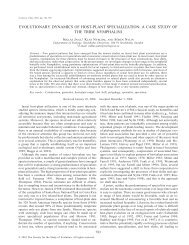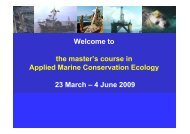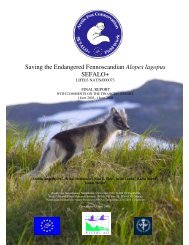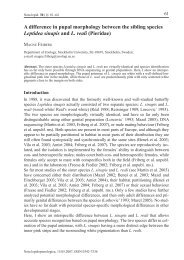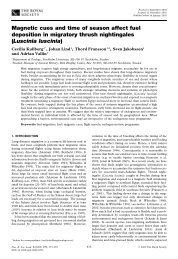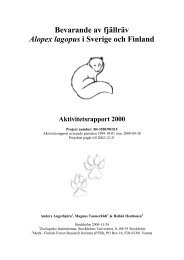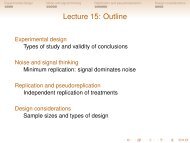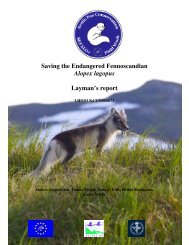The conservation of Fennoscandian arctic foxes - Stockholms ...
The conservation of Fennoscandian arctic foxes - Stockholms ...
The conservation of Fennoscandian arctic foxes - Stockholms ...
You also want an ePaper? Increase the reach of your titles
YUMPU automatically turns print PDFs into web optimized ePapers that Google loves.
and the effect will rather be that <strong>of</strong> fear that such killing could infer. For successful breeding, the <strong>arctic</strong>fox is dependent on specific large dens and studies have shown that <strong>arctic</strong> <strong>foxes</strong> avoid breeding in thevicinity <strong>of</strong> red <strong>foxes</strong> and are accordingly pushed into areas at higher altitudes with lower productivity(Elmhagen et al., 2002). According to data from Finland, where red fox abundance was compared to<strong>arctic</strong> fox abundance (Figure 2.), the red fox had a clear effect on the <strong>arctic</strong> fox dynamics. When thered fox appeared at the traditional <strong>arctic</strong> fox dens in Finland, they first stayed only during the wintersbut after a few years they stayed all year around and also reproduced at these dens. We saw similartrends in the Swedish <strong>arctic</strong> fox areas (Angerbjörn et al., 2002). However, whether the red fox has adirect effect on <strong>arctic</strong> <strong>foxes</strong> through intraguild predation or direct competition is had not yet beeninvestigated. Alternatively the effect shown in the Finnish data set could be due to indirect exploitativecompetition or even a case with no competition at all.Management actions aiming to preserve the <strong>Fennoscandian</strong> <strong>arctic</strong> fox were firstly implemented in theEU/LIFE project SEFALO (1998-2002) by Sweden and Finland and later on in SEFALO+ (2003-2008) by Sweden, Finland and Norway. <strong>The</strong> aims <strong>of</strong> the first phase <strong>of</strong> SEFALO was to halt the presentdeclining population trend and enhance the chances for the species to increase in numbers, bysupplementary feeding and red fox control (Angerbjörn et al., 2002). In the lemming peak year 2001,recruitment to the population was good, especially in the areas where SEFALO had combinedsupplemental feeding with red fox culling. During the second project period, we have used a dynamicmanagement approach to monitor and allocate <strong>conservation</strong> actions to support the species in the mostefficient way. A supplementary feeding programme during both summer and winter has been used inorder to increase reproductive output and juvenile survival and a red fox control programme tosafeguard the best <strong>arctic</strong> fox territories. <strong>The</strong>se actions were implemented within authorities to ensurecontinuation <strong>of</strong> monitoring and <strong>conservation</strong> actions after the proposed project. Supplemental feedinghas earlier been shown to confer an increased cub survival (Tannerfeldt et al., 1994) and an increasednumber <strong>of</strong> litters (Angerbjörn et al., 1991). However, whether supplemental feeding also conveys inan increased litter size has not yet been investigated. Supplementary feeding <strong>of</strong> the <strong>arctic</strong> fox,however, involves a risk <strong>of</strong> attracting red <strong>foxes</strong> to <strong>arctic</strong> fox territories. <strong>The</strong>refore, we consider acombined evaluation <strong>of</strong> both actions necessary since supplementary feeding <strong>of</strong> <strong>arctic</strong> <strong>foxes</strong> involves arisk <strong>of</strong> attracting red <strong>foxes</strong> to <strong>arctic</strong> fox territories. We expect red fox culling to leave more dens andterritories suitable for establishment <strong>of</strong> <strong>arctic</strong> <strong>foxes</strong>, which implies more litters born and higherjuvenile survival due to decreased predation from red <strong>foxes</strong>. Hence, in combination with feeding, weexpect to increase the number <strong>of</strong> successful reproductions. In this report, we aim to evaluate the effect<strong>of</strong> supplemental feeding and red fox culling on the number and size <strong>of</strong> <strong>arctic</strong> fox litters on a local andregional scale. On a local scale, we also aim to separate the effects <strong>of</strong> supplemental feeding from thoseconnected to red fox culling.MATERIAL AND METHODSArctic <strong>foxes</strong> at inhabited dens were fed during winter with commercial dog food (Dogman Dinner), orin some cases remains from reindeer slaughter, by putting out a plastic container within 100 m from anactive den. <strong>The</strong> containers were controlled for <strong>arctic</strong> or red fox activity at least once a month. Red<strong>foxes</strong> have been culled during winter in areas close to recent or previous <strong>arctic</strong> fox territories byrangers in the county administration with special permits for using snowmobiles. All hunting has takenthe utmost caution as not to cause any disturbance to other wildlife. We have classified a territory asbeing hunted if one or several red <strong>foxes</strong> had been shot within 2.3 km from a specific den.To evaluate the effect <strong>of</strong> supplemental feeding and red fox culling on the number and size <strong>of</strong> <strong>arctic</strong> foxlitters on a regional scale, we have used den surveys to investigate presence and breeding success <strong>of</strong>the <strong>arctic</strong> fox in all areas. During the summer inventories, we surveyed all known dens inHelagsfjällen (SE), Borgafjäll (SE), Børgefjell (NO), Vindelfjällen (SE) and parts <strong>of</strong> Norrbotten (SE)for <strong>arctic</strong> fox activity between years 2001-2007. Management actions in Helagsfjällen (SE) andBorgafjäll (SE) have been intense and continual during the entire study period, whereas actions havebeen moderate in Vindelfjällen (SE) and Norrbotten (SE) (Table1). In Børgefjell (NO), no actionshave been implemented. <strong>The</strong>se areas differ in size, in number <strong>of</strong> natal dens (defined as having at least4



